Systems Modelling Assignment 1 Report: ITECH2002 Analysis and Design
VerifiedAdded on 2022/09/08
|10
|1391
|16
Report
AI Summary
This report presents a detailed analysis of system modelling, focusing on the Software Development Life Cycle (SDLC) and its various stages. It begins with a system model analysis and includes a pictorial model of the organization, a high-level organizational chart, and a stakeholder chart to visualize the organizational structure and key players. The report defines the organization's vision and mission statements, along with a system vision statement. It then explores various techniques for gathering information, such as document analysis, focus groups, and observation. The SDLC stages are discussed, emphasizing the analysis, design, implementation, testing, deployment, and maintenance phases. Object-oriented analysis is employed, and a consolidated domain model class diagram is presented to illustrate the system's data objects and functions. References to relevant literature are also included to support the analysis. The assignment demonstrates an understanding of system modelling principles and their practical application in software development.
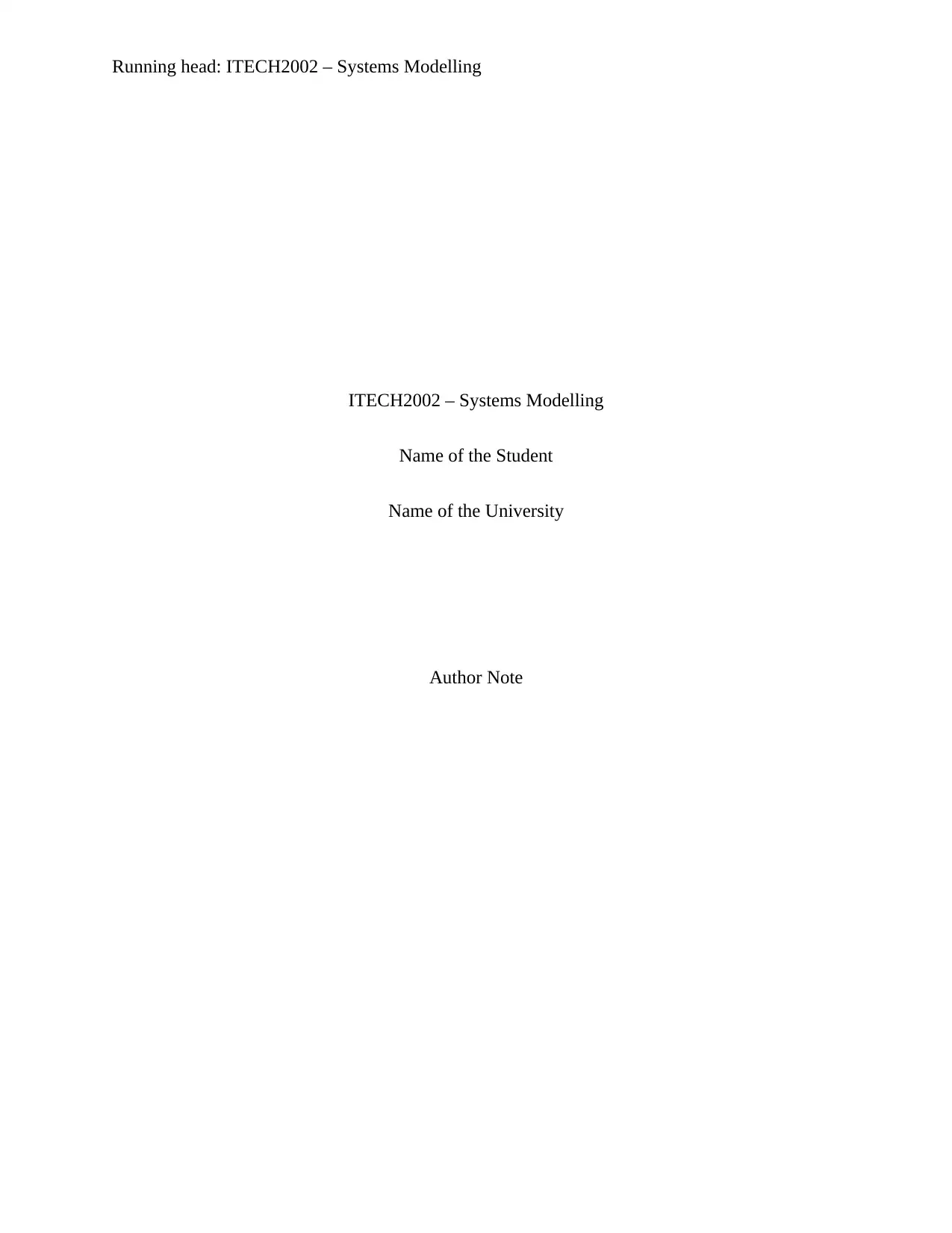
Running head: ITECH2002 – Systems Modelling
ITECH2002 – Systems Modelling
Name of the Student
Name of the University
Author Note
ITECH2002 – Systems Modelling
Name of the Student
Name of the University
Author Note
Paraphrase This Document
Need a fresh take? Get an instant paraphrase of this document with our AI Paraphraser
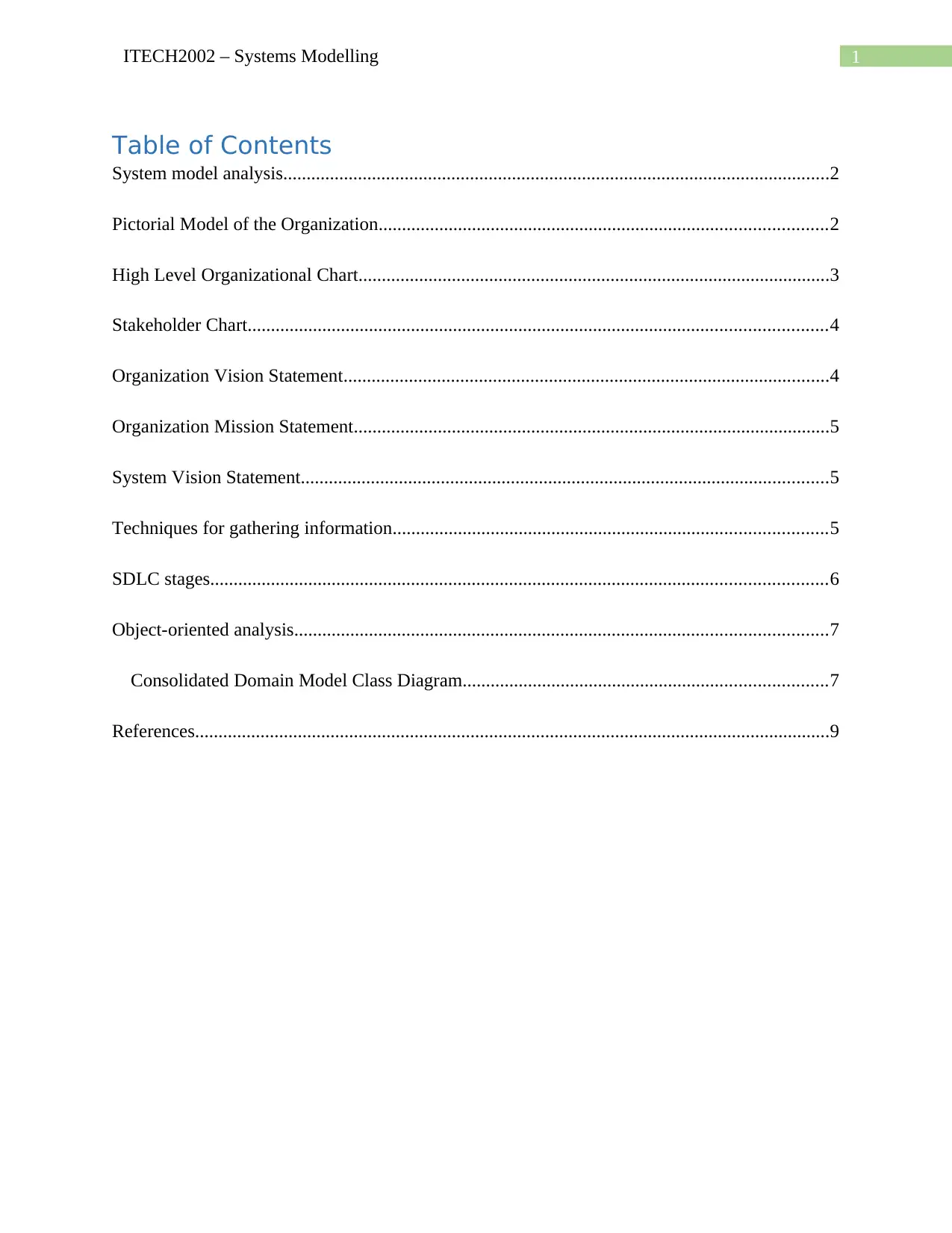
1ITECH2002 – Systems Modelling
Table of Contents
System model analysis.....................................................................................................................2
Pictorial Model of the Organization................................................................................................2
High Level Organizational Chart.....................................................................................................3
Stakeholder Chart............................................................................................................................4
Organization Vision Statement........................................................................................................4
Organization Mission Statement......................................................................................................5
System Vision Statement.................................................................................................................5
Techniques for gathering information.............................................................................................5
SDLC stages....................................................................................................................................6
Object-oriented analysis..................................................................................................................7
Consolidated Domain Model Class Diagram..............................................................................7
References........................................................................................................................................9
Table of Contents
System model analysis.....................................................................................................................2
Pictorial Model of the Organization................................................................................................2
High Level Organizational Chart.....................................................................................................3
Stakeholder Chart............................................................................................................................4
Organization Vision Statement........................................................................................................4
Organization Mission Statement......................................................................................................5
System Vision Statement.................................................................................................................5
Techniques for gathering information.............................................................................................5
SDLC stages....................................................................................................................................6
Object-oriented analysis..................................................................................................................7
Consolidated Domain Model Class Diagram..............................................................................7
References........................................................................................................................................9
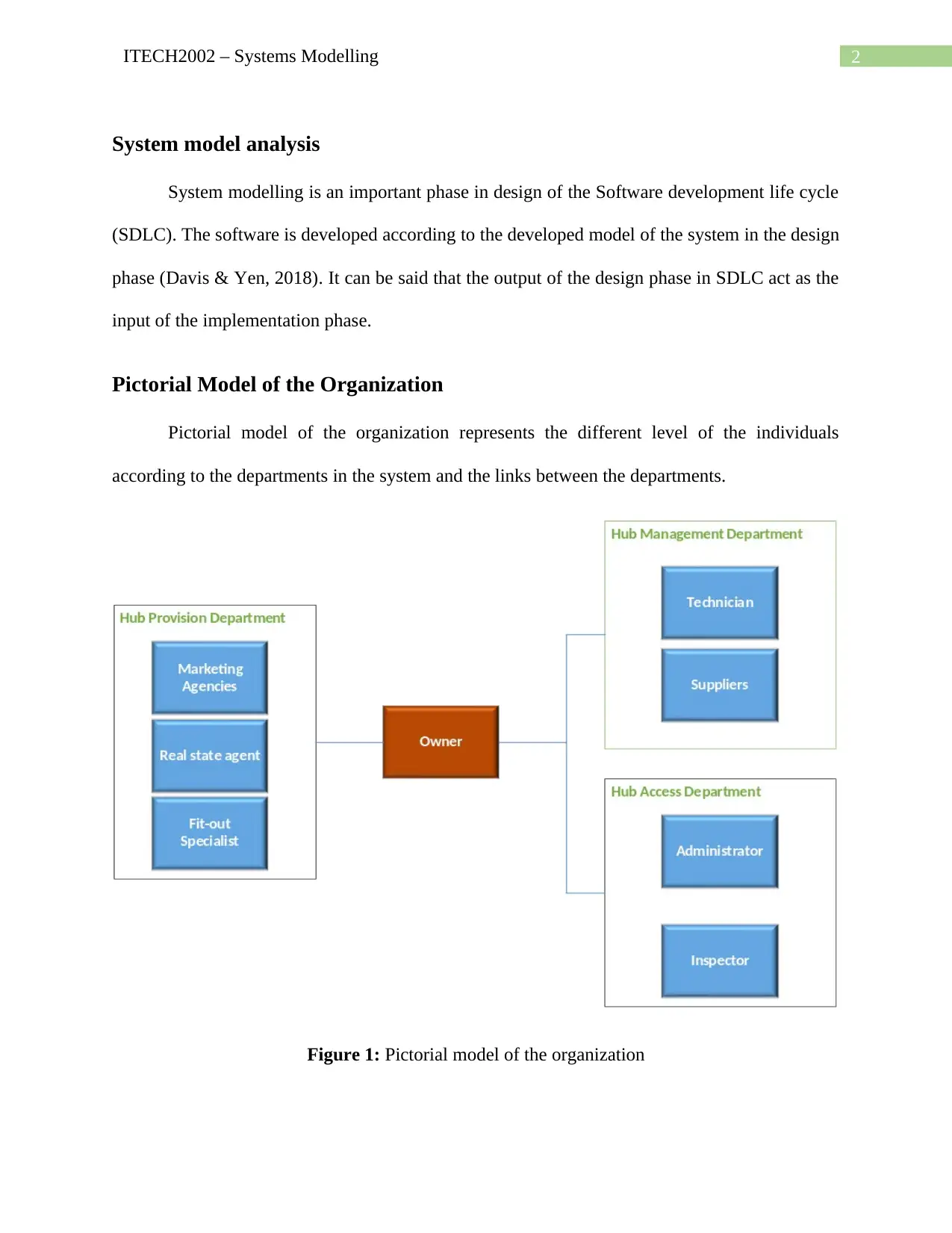
2ITECH2002 – Systems Modelling
System model analysis
System modelling is an important phase in design of the Software development life cycle
(SDLC). The software is developed according to the developed model of the system in the design
phase (Davis & Yen, 2018). It can be said that the output of the design phase in SDLC act as the
input of the implementation phase.
Pictorial Model of the Organization
Pictorial model of the organization represents the different level of the individuals
according to the departments in the system and the links between the departments.
Figure 1: Pictorial model of the organization
System model analysis
System modelling is an important phase in design of the Software development life cycle
(SDLC). The software is developed according to the developed model of the system in the design
phase (Davis & Yen, 2018). It can be said that the output of the design phase in SDLC act as the
input of the implementation phase.
Pictorial Model of the Organization
Pictorial model of the organization represents the different level of the individuals
according to the departments in the system and the links between the departments.
Figure 1: Pictorial model of the organization
⊘ This is a preview!⊘
Do you want full access?
Subscribe today to unlock all pages.

Trusted by 1+ million students worldwide
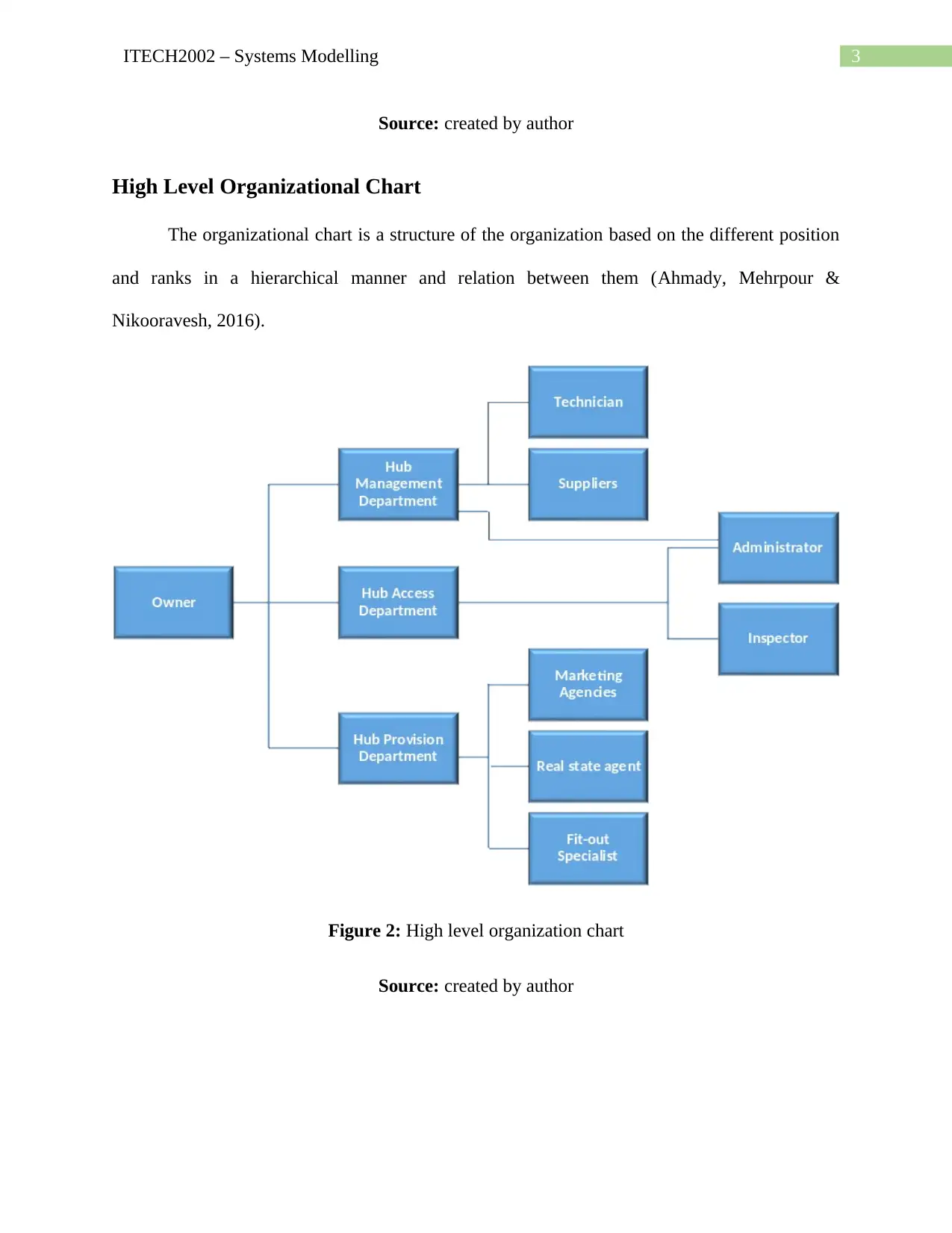
3ITECH2002 – Systems Modelling
Source: created by author
High Level Organizational Chart
The organizational chart is a structure of the organization based on the different position
and ranks in a hierarchical manner and relation between them (Ahmady, Mehrpour &
Nikooravesh, 2016).
Figure 2: High level organization chart
Source: created by author
Source: created by author
High Level Organizational Chart
The organizational chart is a structure of the organization based on the different position
and ranks in a hierarchical manner and relation between them (Ahmady, Mehrpour &
Nikooravesh, 2016).
Figure 2: High level organization chart
Source: created by author
Paraphrase This Document
Need a fresh take? Get an instant paraphrase of this document with our AI Paraphraser
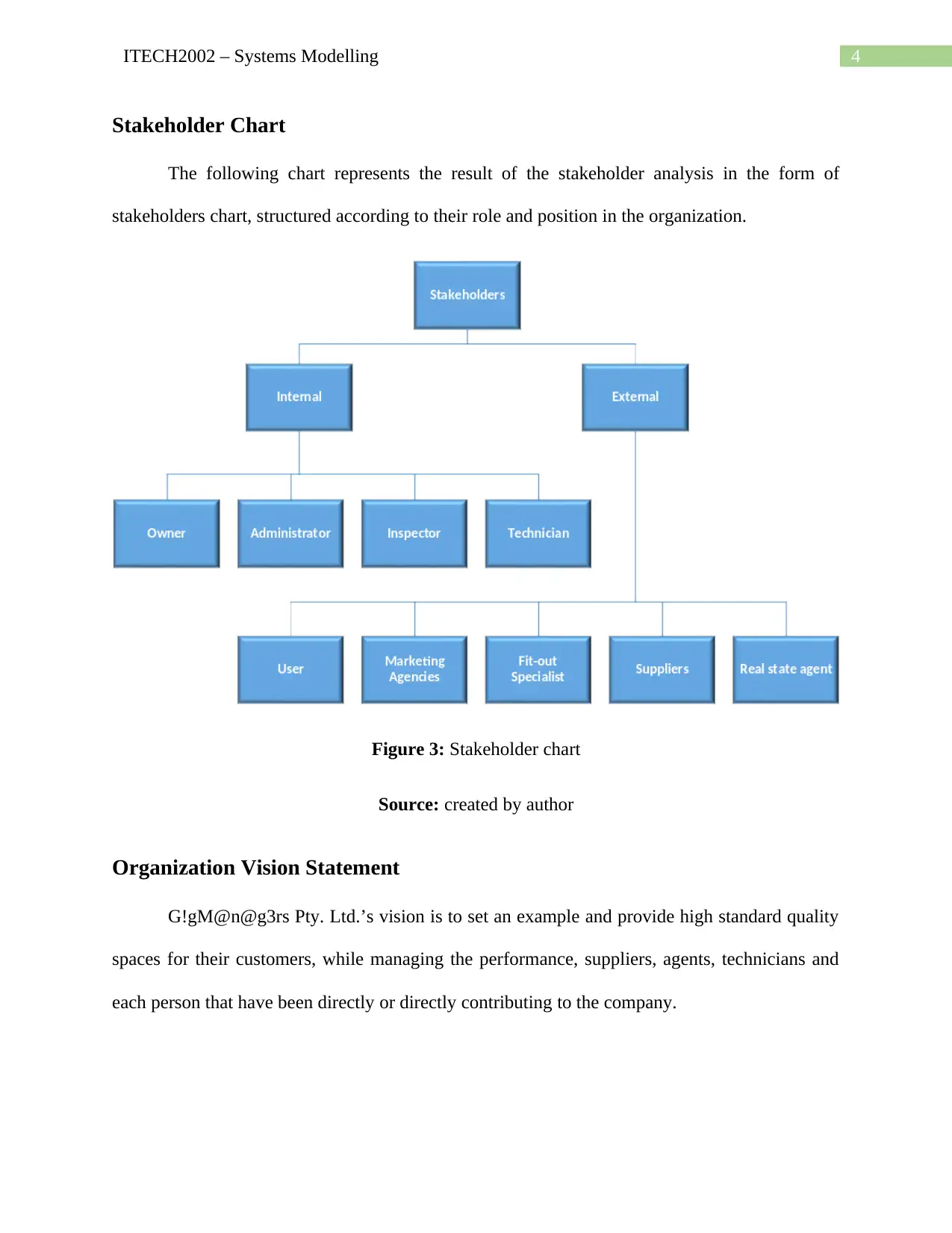
4ITECH2002 – Systems Modelling
Stakeholder Chart
The following chart represents the result of the stakeholder analysis in the form of
stakeholders chart, structured according to their role and position in the organization.
Figure 3: Stakeholder chart
Source: created by author
Organization Vision Statement
G!gM@n@g3rs Pty. Ltd.’s vision is to set an example and provide high standard quality
spaces for their customers, while managing the performance, suppliers, agents, technicians and
each person that have been directly or directly contributing to the company.
Stakeholder Chart
The following chart represents the result of the stakeholder analysis in the form of
stakeholders chart, structured according to their role and position in the organization.
Figure 3: Stakeholder chart
Source: created by author
Organization Vision Statement
G!gM@n@g3rs Pty. Ltd.’s vision is to set an example and provide high standard quality
spaces for their customers, while managing the performance, suppliers, agents, technicians and
each person that have been directly or directly contributing to the company.
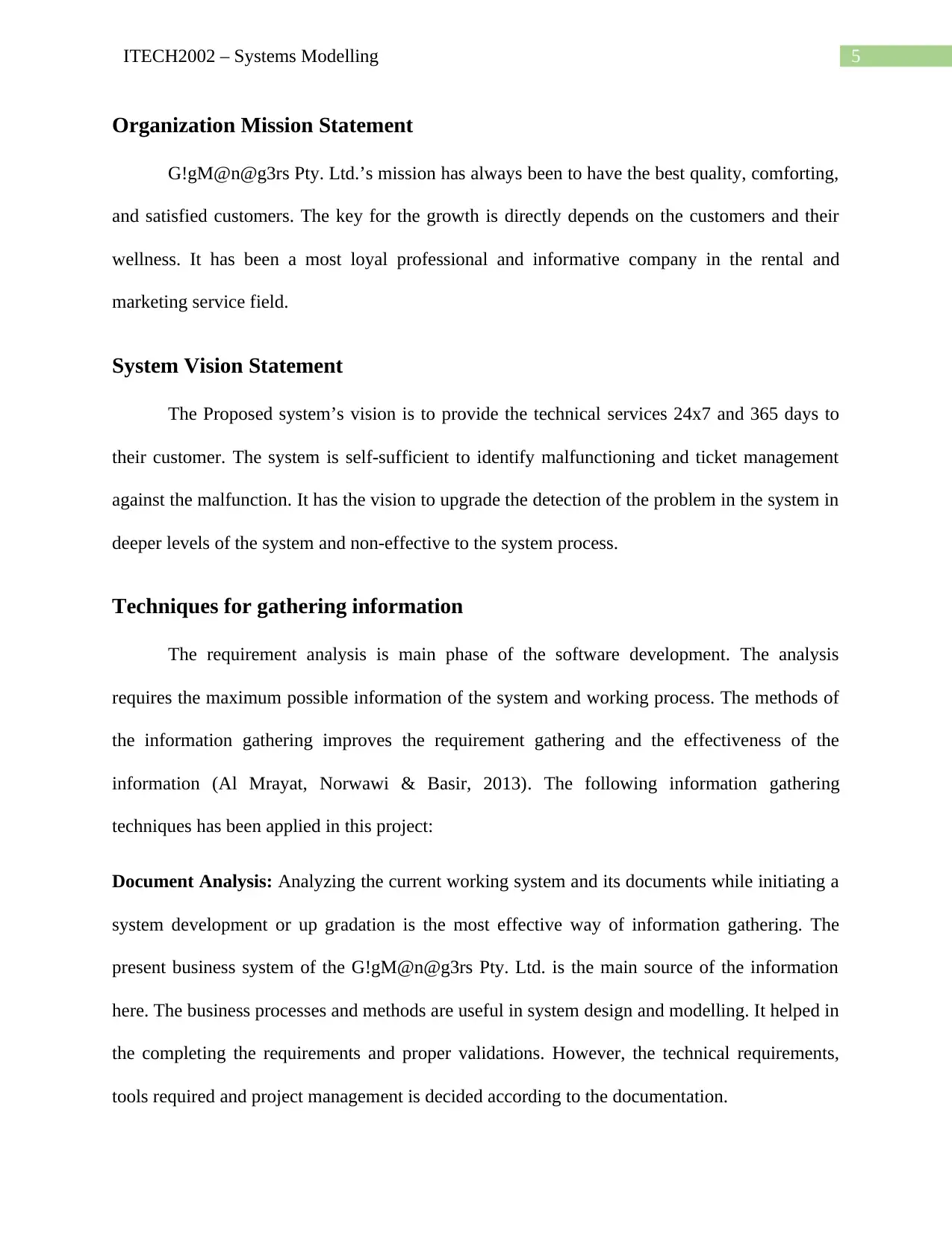
5ITECH2002 – Systems Modelling
Organization Mission Statement
G!gM@n@g3rs Pty. Ltd.’s mission has always been to have the best quality, comforting,
and satisfied customers. The key for the growth is directly depends on the customers and their
wellness. It has been a most loyal professional and informative company in the rental and
marketing service field.
System Vision Statement
The Proposed system’s vision is to provide the technical services 24x7 and 365 days to
their customer. The system is self-sufficient to identify malfunctioning and ticket management
against the malfunction. It has the vision to upgrade the detection of the problem in the system in
deeper levels of the system and non-effective to the system process.
Techniques for gathering information
The requirement analysis is main phase of the software development. The analysis
requires the maximum possible information of the system and working process. The methods of
the information gathering improves the requirement gathering and the effectiveness of the
information (Al Mrayat, Norwawi & Basir, 2013). The following information gathering
techniques has been applied in this project:
Document Analysis: Analyzing the current working system and its documents while initiating a
system development or up gradation is the most effective way of information gathering. The
present business system of the G!gM@n@g3rs Pty. Ltd. is the main source of the information
here. The business processes and methods are useful in system design and modelling. It helped in
the completing the requirements and proper validations. However, the technical requirements,
tools required and project management is decided according to the documentation.
Organization Mission Statement
G!gM@n@g3rs Pty. Ltd.’s mission has always been to have the best quality, comforting,
and satisfied customers. The key for the growth is directly depends on the customers and their
wellness. It has been a most loyal professional and informative company in the rental and
marketing service field.
System Vision Statement
The Proposed system’s vision is to provide the technical services 24x7 and 365 days to
their customer. The system is self-sufficient to identify malfunctioning and ticket management
against the malfunction. It has the vision to upgrade the detection of the problem in the system in
deeper levels of the system and non-effective to the system process.
Techniques for gathering information
The requirement analysis is main phase of the software development. The analysis
requires the maximum possible information of the system and working process. The methods of
the information gathering improves the requirement gathering and the effectiveness of the
information (Al Mrayat, Norwawi & Basir, 2013). The following information gathering
techniques has been applied in this project:
Document Analysis: Analyzing the current working system and its documents while initiating a
system development or up gradation is the most effective way of information gathering. The
present business system of the G!gM@n@g3rs Pty. Ltd. is the main source of the information
here. The business processes and methods are useful in system design and modelling. It helped in
the completing the requirements and proper validations. However, the technical requirements,
tools required and project management is decided according to the documentation.
⊘ This is a preview!⊘
Do you want full access?
Subscribe today to unlock all pages.

Trusted by 1+ million students worldwide
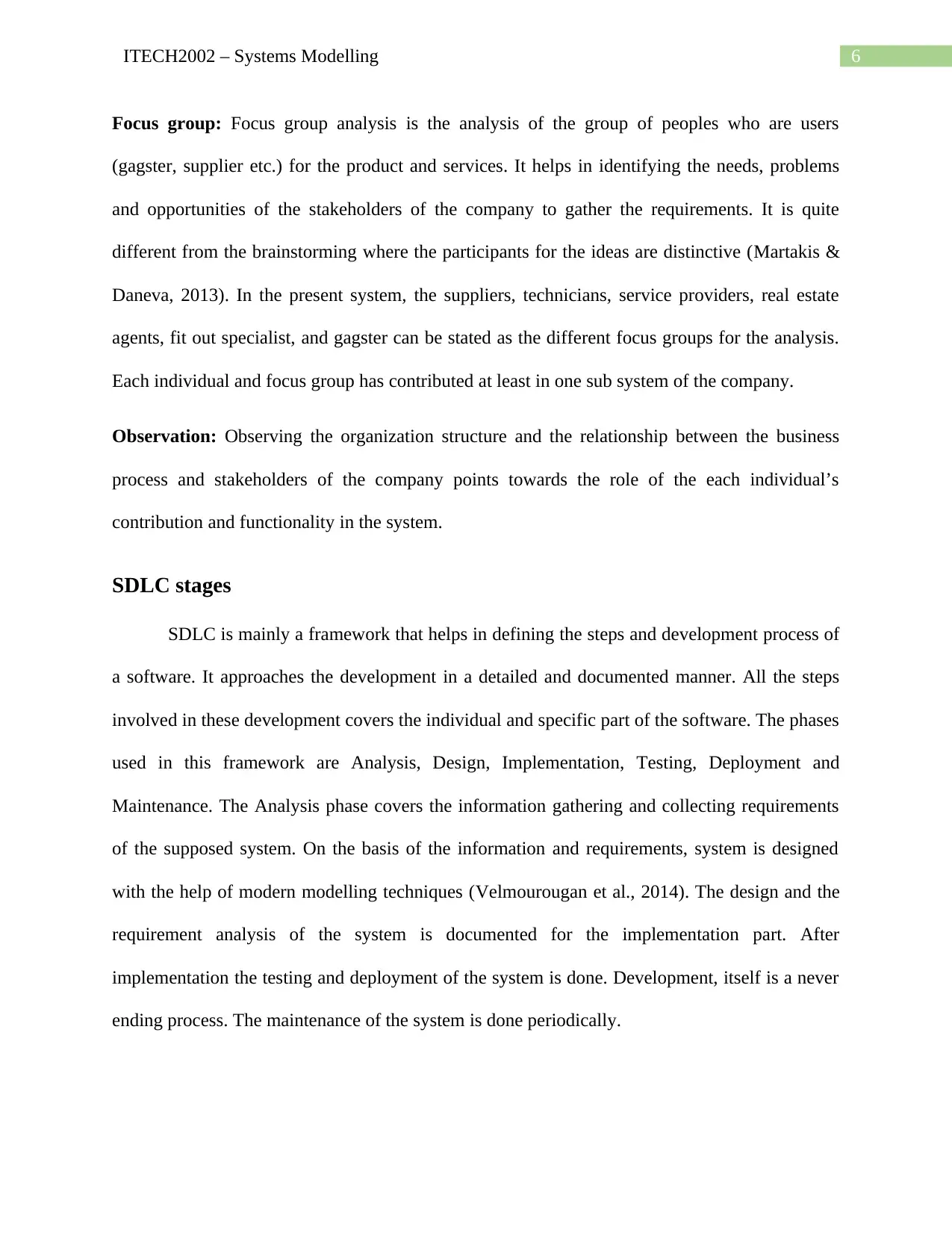
6ITECH2002 – Systems Modelling
Focus group: Focus group analysis is the analysis of the group of peoples who are users
(gagster, supplier etc.) for the product and services. It helps in identifying the needs, problems
and opportunities of the stakeholders of the company to gather the requirements. It is quite
different from the brainstorming where the participants for the ideas are distinctive (Martakis &
Daneva, 2013). In the present system, the suppliers, technicians, service providers, real estate
agents, fit out specialist, and gagster can be stated as the different focus groups for the analysis.
Each individual and focus group has contributed at least in one sub system of the company.
Observation: Observing the organization structure and the relationship between the business
process and stakeholders of the company points towards the role of the each individual’s
contribution and functionality in the system.
SDLC stages
SDLC is mainly a framework that helps in defining the steps and development process of
a software. It approaches the development in a detailed and documented manner. All the steps
involved in these development covers the individual and specific part of the software. The phases
used in this framework are Analysis, Design, Implementation, Testing, Deployment and
Maintenance. The Analysis phase covers the information gathering and collecting requirements
of the supposed system. On the basis of the information and requirements, system is designed
with the help of modern modelling techniques (Velmourougan et al., 2014). The design and the
requirement analysis of the system is documented for the implementation part. After
implementation the testing and deployment of the system is done. Development, itself is a never
ending process. The maintenance of the system is done periodically.
Focus group: Focus group analysis is the analysis of the group of peoples who are users
(gagster, supplier etc.) for the product and services. It helps in identifying the needs, problems
and opportunities of the stakeholders of the company to gather the requirements. It is quite
different from the brainstorming where the participants for the ideas are distinctive (Martakis &
Daneva, 2013). In the present system, the suppliers, technicians, service providers, real estate
agents, fit out specialist, and gagster can be stated as the different focus groups for the analysis.
Each individual and focus group has contributed at least in one sub system of the company.
Observation: Observing the organization structure and the relationship between the business
process and stakeholders of the company points towards the role of the each individual’s
contribution and functionality in the system.
SDLC stages
SDLC is mainly a framework that helps in defining the steps and development process of
a software. It approaches the development in a detailed and documented manner. All the steps
involved in these development covers the individual and specific part of the software. The phases
used in this framework are Analysis, Design, Implementation, Testing, Deployment and
Maintenance. The Analysis phase covers the information gathering and collecting requirements
of the supposed system. On the basis of the information and requirements, system is designed
with the help of modern modelling techniques (Velmourougan et al., 2014). The design and the
requirement analysis of the system is documented for the implementation part. After
implementation the testing and deployment of the system is done. Development, itself is a never
ending process. The maintenance of the system is done periodically.
Paraphrase This Document
Need a fresh take? Get an instant paraphrase of this document with our AI Paraphraser
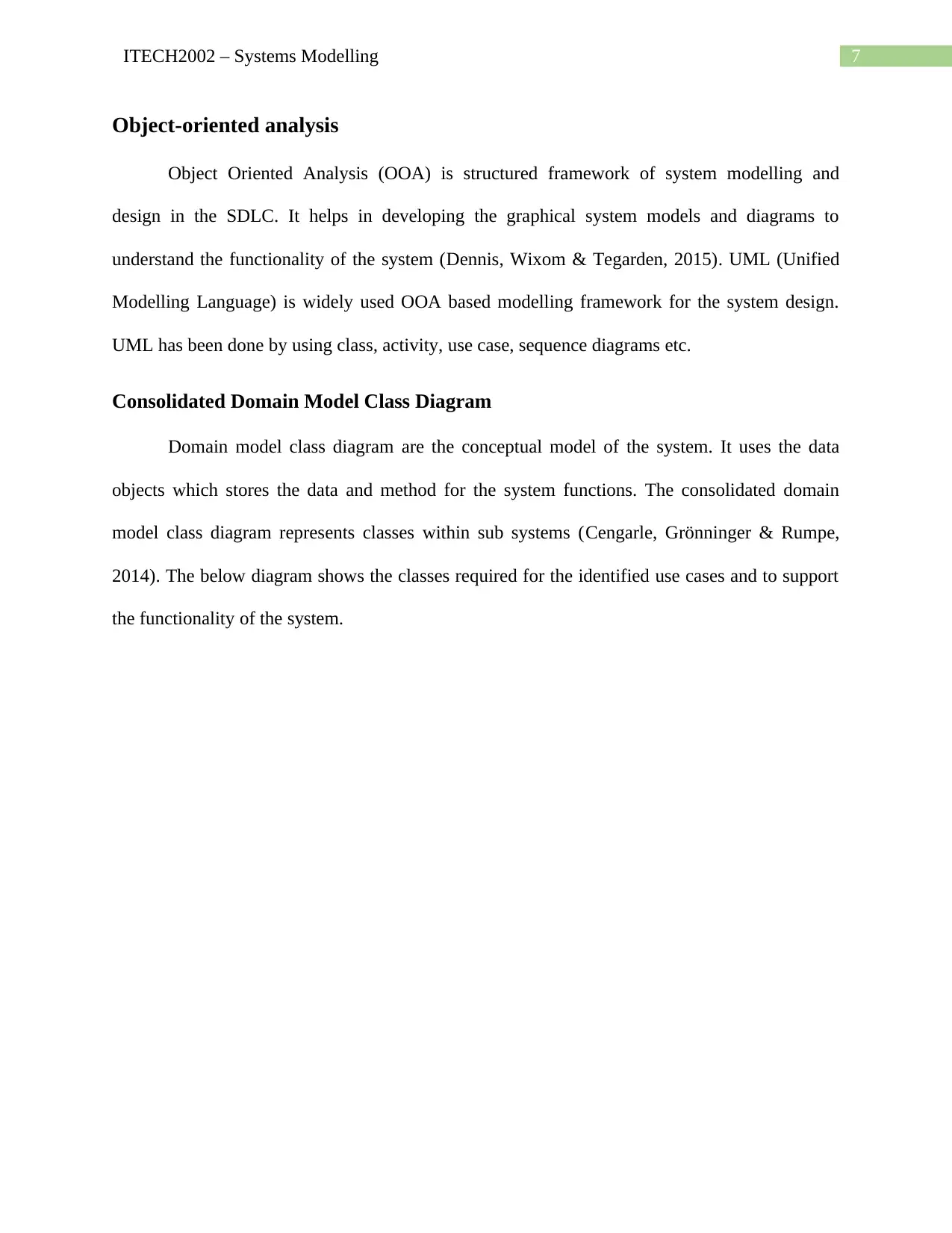
7ITECH2002 – Systems Modelling
Object-oriented analysis
Object Oriented Analysis (OOA) is structured framework of system modelling and
design in the SDLC. It helps in developing the graphical system models and diagrams to
understand the functionality of the system (Dennis, Wixom & Tegarden, 2015). UML (Unified
Modelling Language) is widely used OOA based modelling framework for the system design.
UML has been done by using class, activity, use case, sequence diagrams etc.
Consolidated Domain Model Class Diagram
Domain model class diagram are the conceptual model of the system. It uses the data
objects which stores the data and method for the system functions. The consolidated domain
model class diagram represents classes within sub systems (Cengarle, Grönninger & Rumpe,
2014). The below diagram shows the classes required for the identified use cases and to support
the functionality of the system.
Object-oriented analysis
Object Oriented Analysis (OOA) is structured framework of system modelling and
design in the SDLC. It helps in developing the graphical system models and diagrams to
understand the functionality of the system (Dennis, Wixom & Tegarden, 2015). UML (Unified
Modelling Language) is widely used OOA based modelling framework for the system design.
UML has been done by using class, activity, use case, sequence diagrams etc.
Consolidated Domain Model Class Diagram
Domain model class diagram are the conceptual model of the system. It uses the data
objects which stores the data and method for the system functions. The consolidated domain
model class diagram represents classes within sub systems (Cengarle, Grönninger & Rumpe,
2014). The below diagram shows the classes required for the identified use cases and to support
the functionality of the system.
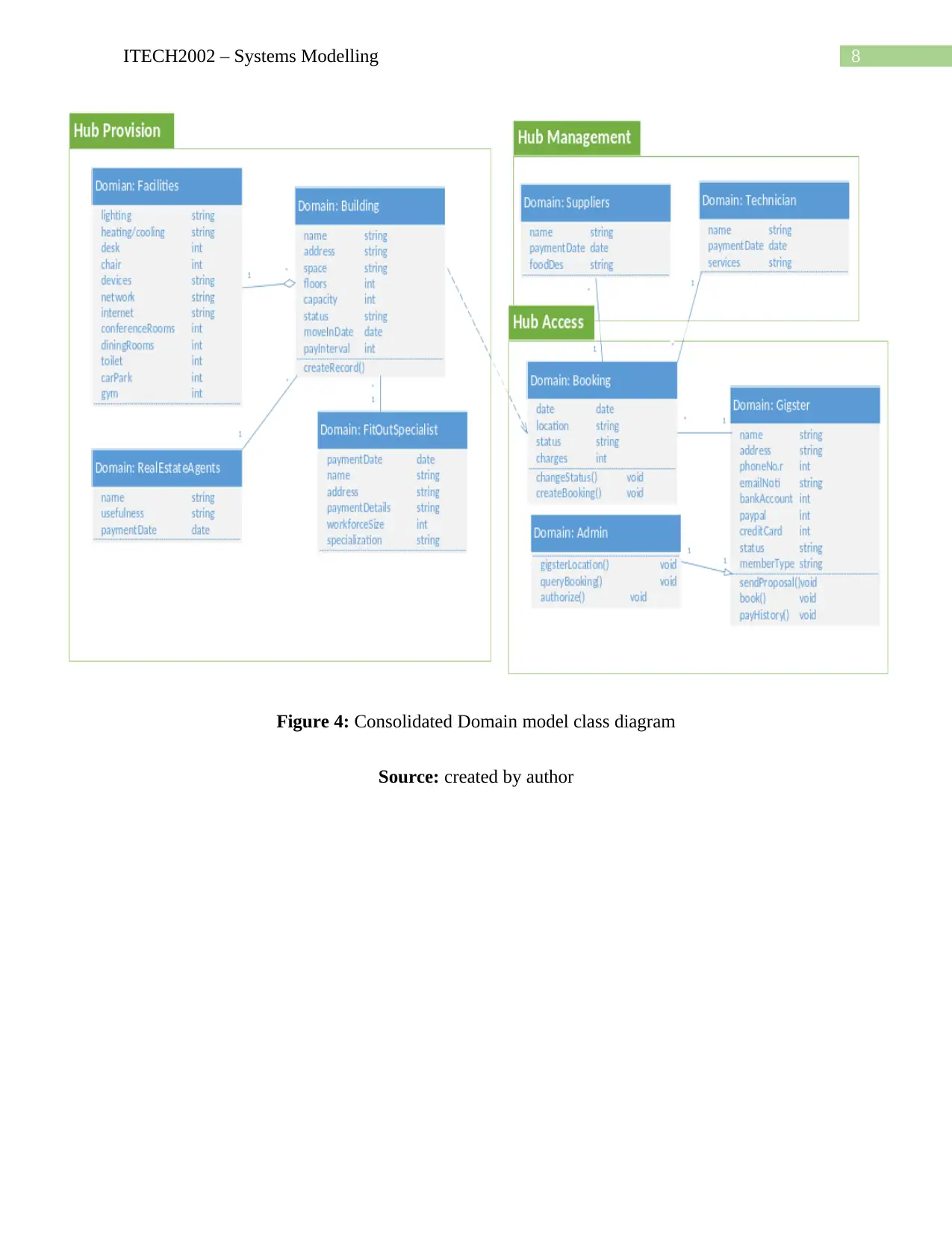
8ITECH2002 – Systems Modelling
Figure 4: Consolidated Domain model class diagram
Source: created by author
Figure 4: Consolidated Domain model class diagram
Source: created by author
⊘ This is a preview!⊘
Do you want full access?
Subscribe today to unlock all pages.

Trusted by 1+ million students worldwide
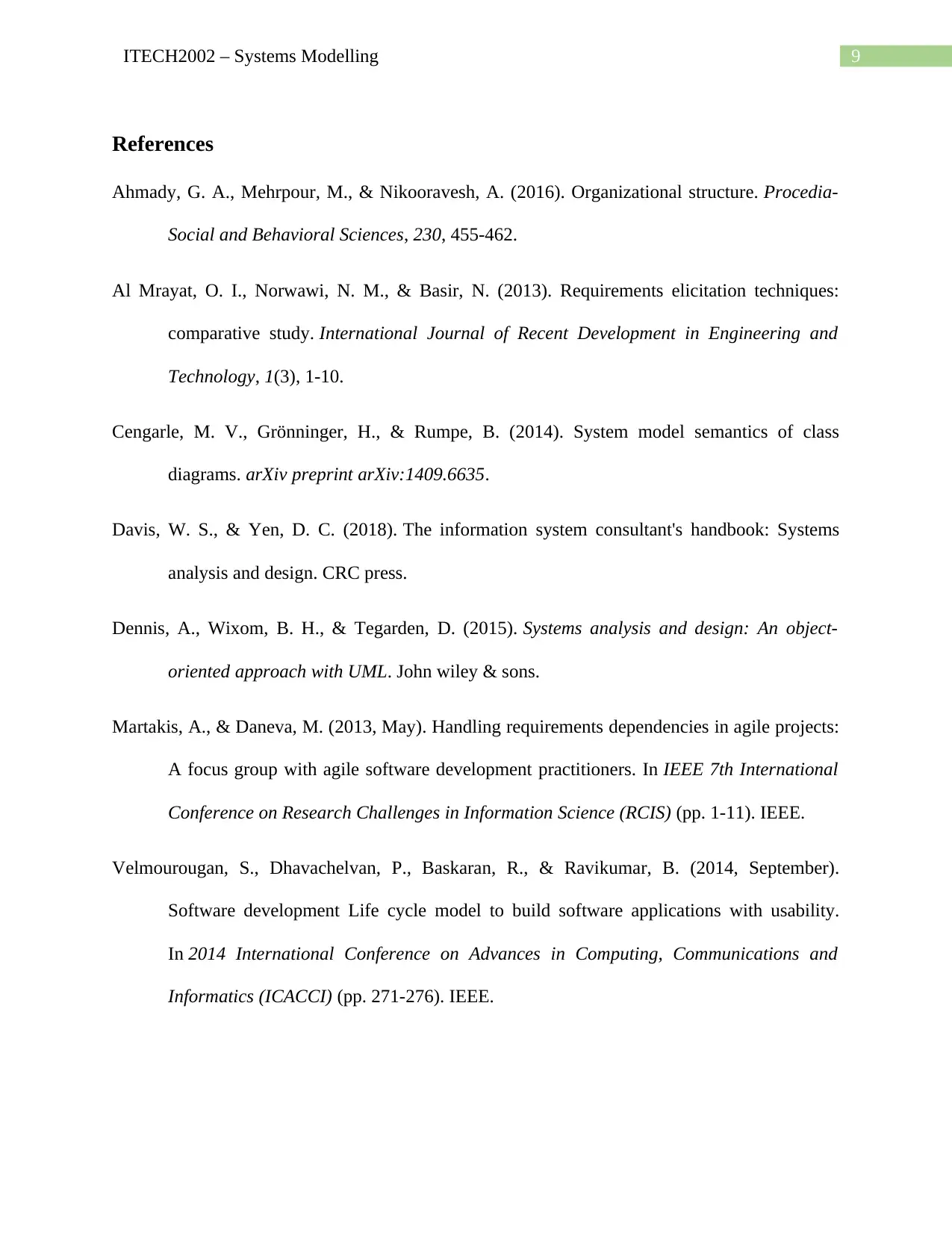
9ITECH2002 – Systems Modelling
References
Ahmady, G. A., Mehrpour, M., & Nikooravesh, A. (2016). Organizational structure. Procedia-
Social and Behavioral Sciences, 230, 455-462.
Al Mrayat, O. I., Norwawi, N. M., & Basir, N. (2013). Requirements elicitation techniques:
comparative study. International Journal of Recent Development in Engineering and
Technology, 1(3), 1-10.
Cengarle, M. V., Grönninger, H., & Rumpe, B. (2014). System model semantics of class
diagrams. arXiv preprint arXiv:1409.6635.
Davis, W. S., & Yen, D. C. (2018). The information system consultant's handbook: Systems
analysis and design. CRC press.
Dennis, A., Wixom, B. H., & Tegarden, D. (2015). Systems analysis and design: An object-
oriented approach with UML. John wiley & sons.
Martakis, A., & Daneva, M. (2013, May). Handling requirements dependencies in agile projects:
A focus group with agile software development practitioners. In IEEE 7th International
Conference on Research Challenges in Information Science (RCIS) (pp. 1-11). IEEE.
Velmourougan, S., Dhavachelvan, P., Baskaran, R., & Ravikumar, B. (2014, September).
Software development Life cycle model to build software applications with usability.
In 2014 International Conference on Advances in Computing, Communications and
Informatics (ICACCI) (pp. 271-276). IEEE.
References
Ahmady, G. A., Mehrpour, M., & Nikooravesh, A. (2016). Organizational structure. Procedia-
Social and Behavioral Sciences, 230, 455-462.
Al Mrayat, O. I., Norwawi, N. M., & Basir, N. (2013). Requirements elicitation techniques:
comparative study. International Journal of Recent Development in Engineering and
Technology, 1(3), 1-10.
Cengarle, M. V., Grönninger, H., & Rumpe, B. (2014). System model semantics of class
diagrams. arXiv preprint arXiv:1409.6635.
Davis, W. S., & Yen, D. C. (2018). The information system consultant's handbook: Systems
analysis and design. CRC press.
Dennis, A., Wixom, B. H., & Tegarden, D. (2015). Systems analysis and design: An object-
oriented approach with UML. John wiley & sons.
Martakis, A., & Daneva, M. (2013, May). Handling requirements dependencies in agile projects:
A focus group with agile software development practitioners. In IEEE 7th International
Conference on Research Challenges in Information Science (RCIS) (pp. 1-11). IEEE.
Velmourougan, S., Dhavachelvan, P., Baskaran, R., & Ravikumar, B. (2014, September).
Software development Life cycle model to build software applications with usability.
In 2014 International Conference on Advances in Computing, Communications and
Informatics (ICACCI) (pp. 271-276). IEEE.
1 out of 10
Related Documents
Your All-in-One AI-Powered Toolkit for Academic Success.
+13062052269
info@desklib.com
Available 24*7 on WhatsApp / Email
![[object Object]](/_next/static/media/star-bottom.7253800d.svg)
Unlock your academic potential
Copyright © 2020–2025 A2Z Services. All Rights Reserved. Developed and managed by ZUCOL.





